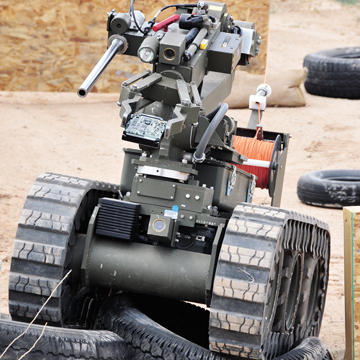
Whether it’s the terrorist group al-Qaida, a troubled teenager, a meth-head, or a member of a drug cartel leaving an unexploded bomb at a location near you, no one wants the bomb squad showing up with a robot for which they’re still reading the instruction manual.
To help avoid delays that could risk lives, a “robot rodeo” held last week at Sandia provided 10 scenarios to familiarize bomb squad members from different New Mexico locations with five kinds of robots they may need to operate on short notice.
The point of the spirited competition was to give bomb squads practice operating their own equipment in real-time difficult scenarios, as well as the opportunity to familiarize themselves with robots unavailable on their home turf that they may need to operate when supporting another community.
“Our first responders need to be able to operate on many fields,” says Jake Deuel, manager of Mobile Robotics Dept. 6472. Jake co-led the third annual Western National Robot Rodeo with Chris Ory from Los Alamos National Laboratories.
“If guys from APD [Albuquerque Police Dept.] need to backstop the Santa Fe police force in an emergency, it will be helpful to have experienced some of their tools in advance,” says Ory.
One scenario involved removing explosives placed by a terrorist in an overhead luggage compartment of an airplane and under its seats [see boxed scenario.] This was not as simple as it first appeared. Operators, working at remote distances with site information provided by a video camera on the robot, had to maneuver up and down narrow plane corridors and between even narrower seating. Fiber optic cables that carried not only video from robot to operator but instructions from operator to robot had to remain undamaged and uncut. Murphy’s Law caused seat trays to drop unexpectedly, hindering explosive device removal. Even more insidious were the effects of obstructions beyond the operator’s immediate view.
In other scenarios, the teams used robots to explore a ravine for tripwires of the type used to set off IEDs (improvised explosive devices). They also were involved in a kind of NASCAR rapid-repair effort to replace a robot’s treads, maneuvered through a minefield to recover a hard drive, and dragged a fallen bomb tech out of what seemed to be a crack house before disabling and removing what could have been a bomb. Other scenarios involved securing a communications facility and removing bombs set near two water reservoirs.
The most imaginative scenario: A DC9 transporting captured space aliens, of the kind popularized in the movie Men in Black, has had to land in Albuquerque. Robots must maneuver among the downed aliens and the plastic tubes of their life-support system to retrieve the government team’s memory-erasing light tubes.
The fantastic scenario and those more grounded in potential real-world situations demanded intense concentration. As Jake recounts, “One team reported to its leadership that ‘we think this is going to be a little harder than we first thought.’”
Competing to show the most effective techniques on key steps in each scenario were teams from the Albuquerque Police Department, Santa Fe Police Department, New Mexico State Police, Kirtland Air Force Base, and Los Alamos National Laboratory.
Evidence of the worth of the training was apparent, says Jake, when he was told by the KAFB team leader that their youngest operators were getting the most stick time (driving time) because they were being deployed to Afghanistan in the near term.
“Imagine how valuable the Air Forces thought this training would be for them,” says Jake. At the awards ceremony on Thursday afternoon as part of the after-action debriefing for the competitors, Sgt. Chris Jackson, AF EOD, said, “This was the best training we’ve had.”
Robot limitations brought into sharp relief by the competition will cause Sandia roboticists to suggest projects for DOE and other agency funding, Jake says. Technical improvements are adopted by the robotics companies who sell the robots. Meanwhile, participants in the competition learn about the latest innovations.
“It’s a door that swings several ways,” says Lawrence Vasquez of the Santa Fe bomb team.
Nothing is as easy as it seems
People who read about bomb squads arriving on the scene to remove explosives might be surprised to learn how utterly human is the process by which flesh-and-blood people learn to control the robots that perform the removal process.
In one scenario, a robot enters a three-story cinderblock house clutching a PAN disrupter. Its intent is to shoot a high-pressure stream of water at a possibly dangerous device known to be somewhere in the building. It trundles up a set of unvarnished concrete stairs bordered by an unadorned metal handrail to the second floor — a world of unfinished particle-board walls and narrow, dimly lit hallways. Down one hallway is a suspicious package the size of a hip pouch. But at the top of the stairs, a prone dummy — the dressed simulation of an unconscious bomb tech in his bomb suit — blocks the robot’s path.
Back at the control center, sheltered about 100 feet from the building, the team operating the robot has a choice to make. Do they drive over the fallen worker to get to the device? It’s a 100-pound robot, which makes it 50 pounds on each wheel.
The question is moot because the little robot cannot bestride the man. The operators descend the robot down the ominous stairs and a bigger one — the Remotec Andros F-6A — ascends, forward gripper ready to haul the victim to safety and by doing so, clear the path for the smaller robot.
But take hold of the victim where?
“How can I grab him?” asks the operator at the keyboard, watching the video screen showing a robot’s-eye-view of the fallen worker.
“If it’s ever me,” says another squad member, “you can grab me by my head.”